In the world of custom motorcycles, there are a variety of popular styles ranging from classic bobbers and café racers through to wild choppers and modern streetfighters – with many sci-fi or avant-garde inspired.
There is probably a genre for every taste, with many hinging upon a few key details that make a style distinct from others. One style that is less cohesive and consistent, but produces some of the coolest shapes, is what I like to call “slim & trim,” which sees bikes reduced to the cleanest lines possible, often keeping the frame almost impossibly skinny for a pencil-thin silhouette.
Some motorcycles going this route end up looking like missiles with wheels, resulting in minimalist bodies with few superfluous details. Others simply comprise a singular shape to uncomplicate the profile.
Singaporean bike builder Bandit9 has had some fantastic examples of this with its Odyssey, Eve, and L-Concept creations. These bikes have even been featured in the MB&F M.A.D.Galleries as objects of extreme design.
These are compellingly stunning, though another bike builder has taken the concept of “slim & trim” even further, creating a motorcycle bordering on invisible: Berlin-based Urban Motor has taken a 1964 Jawa 350 and turned it into a sprint bike, an ultra-thin beauty designed to look incredible and fast while it’s decidedly not.
Inspired to compete in Glemseck 101 – the largest motorcycle gathering in Europe – the folks at Urban Motor went for style over speed and created a bike that is only inches wide along most of its length, making if feel more like a piece of art than a machine. Dubbed the “Easy Like Sunday Morning,” the bike represents the pinnacle of “slim & trim” design in motorcycles.
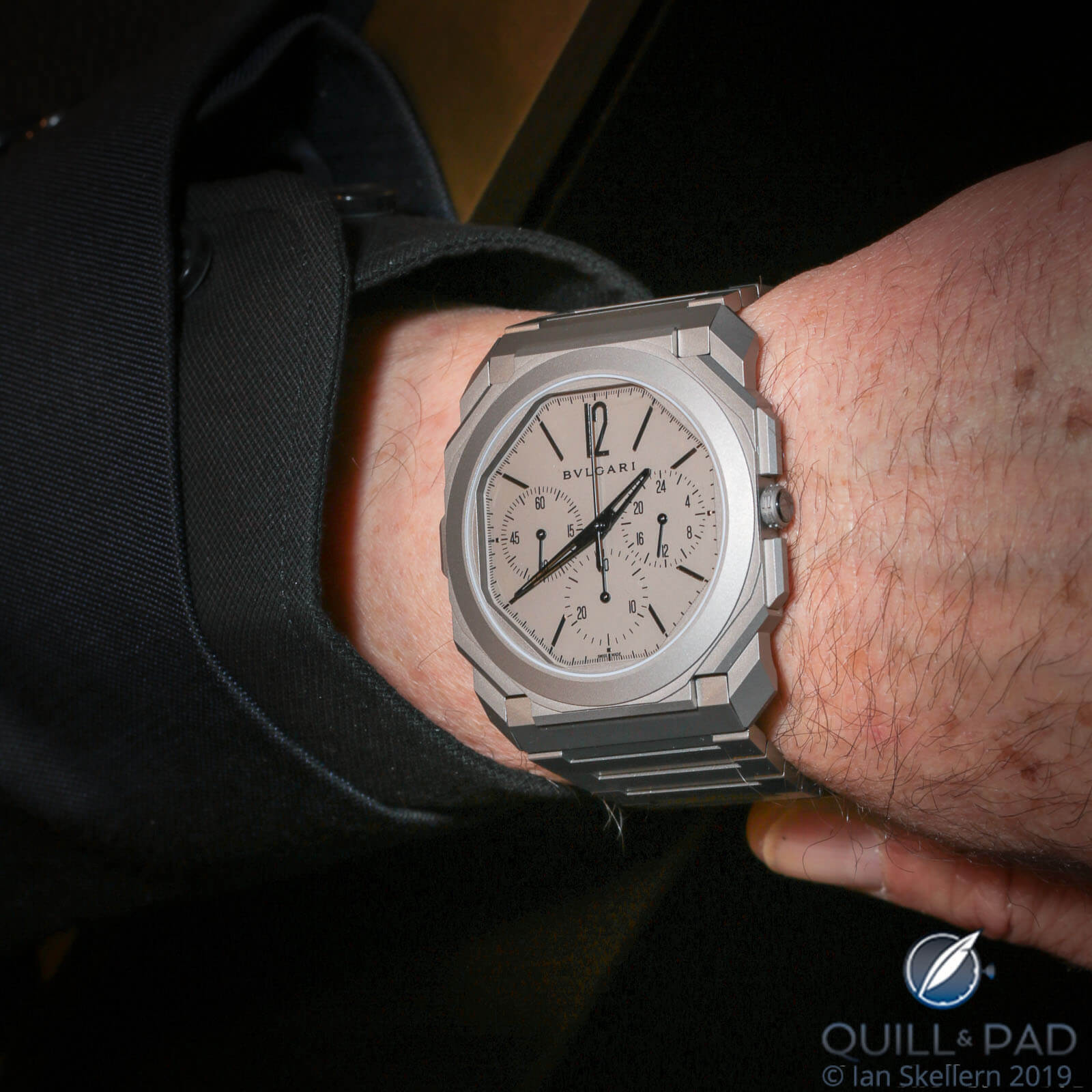
Bulgari Octo Finissimo Chronograph GMT on the wrist
It also represents some of the same principles used to develop the Bulgari Octo Finissimo Chronograph GMT, the recent winner of the Chronograph category of the 2019 Grand Prix d’Horlogerie de Genève and current world record holder for the thinnest mechanical chronograph.
As a record holder it deserves closer inspection to discover just how it achieved this feat while looking this cool in the process.
Modern design of Bulgari’s Octo Finissimo Chronograph GMT
Over the last half decade Bulgari has racked up world records pretty much yearly with five since 2014, debuting a world record in thinness every year except 2015.
It all began with the launch of the Octo Finissimo Tourbillon, the world’s thinnest tourbillon watch. Bulgari followed that up with the world’s thinnest minute repeater, the world’s thinnest automatic watch, and then the world’s thinnest automatic tourbillon in 2018.

Bulgari Octo Finissimo Chronograph GMT
Right on schedule Bulgari released the Octo Finissimo Chronograph GMT at Baselworld 2019, the world’s thinnest automatic chronograph (with an added GMT function for good measure!), proving once again why we all need to take Bulgari seriously as a watchmaker.
The Octo Finissimo Chronograph GMT follows the same styling and design cues first launched with the original Octo Finissimo Tourbillon, which itself was a stylized continuation of the long-running Octo line from Bulgari.
Inspired by the coffered ceiling of the Basilica of Maxentius in Rome’s Forum Romanum, the design aggressively pushes the octagon and chamfered edges juxtaposed with a round bezel, all presented in muted, monochrome grey.
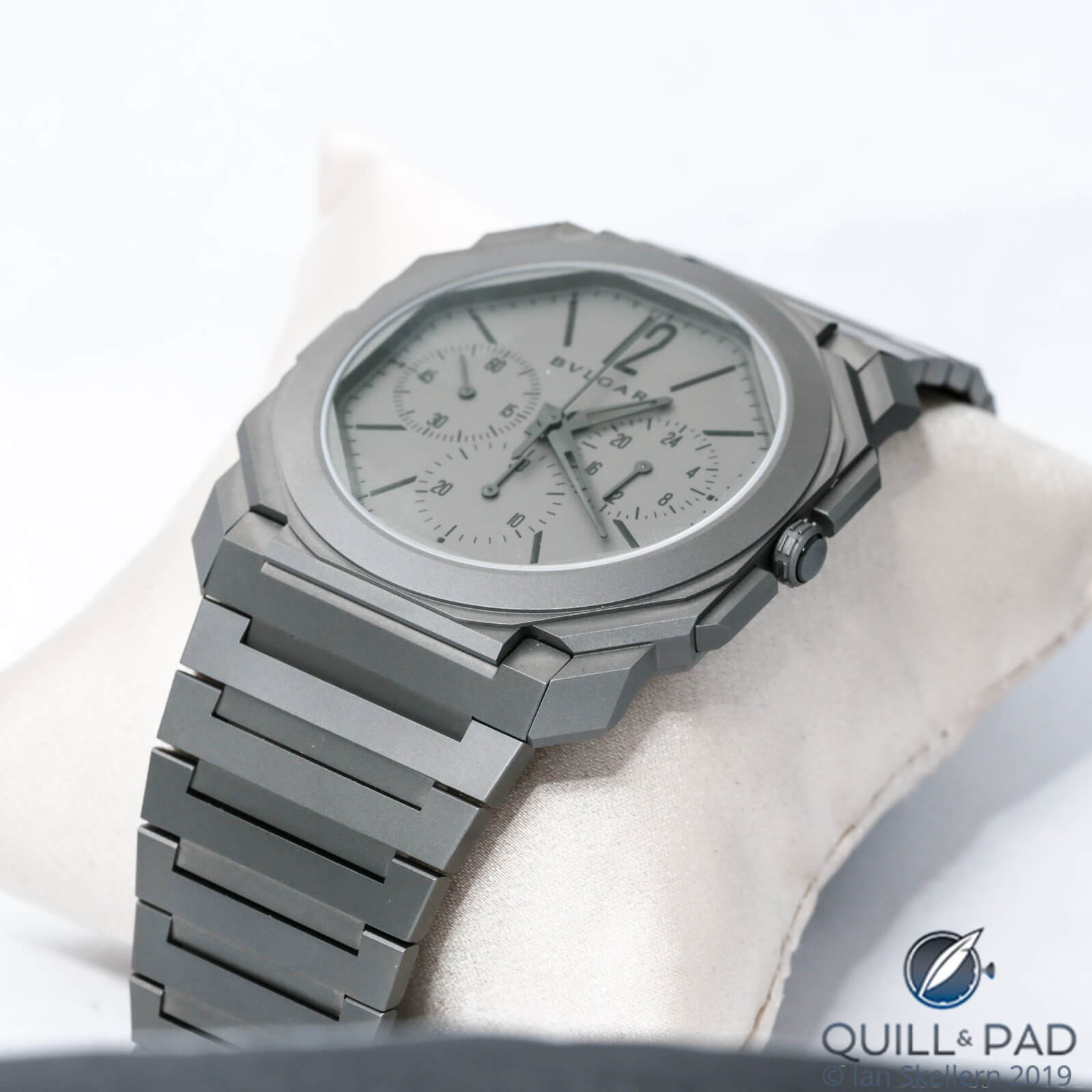
Bulgari Octo Finissimo Chronograph GMT
The case, though thin, has a variety of levels that allows for a lot of visual complexity, something that is often not present in ultra-slim watches. If anything, the design belies its true thinness and makes it look like it must be thicker than it is in reality.
When you combine this with the titanium construction, the watch feels almost impossibly thin – too thin to house an automatic chronograph with added GMT function. The piece, like its predecessors, also sports a full titanium bracelet with a similar faceted style that makes the watch extra sturdy yet maintains supreme lightness.
The dial’s displays give a hint to the engineering behind the watch with running seconds, a chronograph minute counter, and a 24-hour GMT subdial.

Bulgari Octo Finissimo Chronograph GMT
The main hour hand showing local time has a quick-adjuster pusher on the left side of the case. The layout is visually very similar to the standard 3-6-9 layout of many chronographs but arguably provides more useful functionality compared to the standard chronograph.
I know I have never used a chronograph to count anything over an hour, let alone over 30 minutes. And I imagine that might be true for many. So taking out the hour counter and replacing it with the GMT subdial provides a lot more day-to-day functionality.
Shifts create opportunities
Changing the chronograph subdial’s function to a second time zone should make the miniaturization of the chronograph mechanism simpler as well: a 24-hour subdial can be achieved with either one or two extra gears on the same plane as the hour wheel, therefore not requiring any additional thickness.
However, an hour counter with a reset mechanism takes up multiple layers and since it is in line with the winding mechanism underneath, that means a thicker movement no matter what.
These are the types of opportunities the Bulgari technicians looked for when they developed the new BVL 318 caliber.
The team at Bulgari redesigned the entire chronograph mechanism in order to redistribute components to minimize stack-up, instead spreading the mechanism out with less overlaps to keep thickness down.
That is why the diameter of the movement is a large 37.2 mm: when you can’t go up, you go out.

Bulgari Octo Finissimo Chronograph GMT
The change to a GMT eliminated the stack-up associated with a resettable hour counter, so it didn’t need to be contended with at all. This meant that only the minute counter and chronograph seconds would need a reset mechanism, saving precious thickness and space during the engineering phase.
This chronograph is also a column wheel-actuated mechanism with a horizontal clutch, a very smooth design that keeps thickness down and still provides reliable functionality.
It might be obvious to an engineer that the vertical clutch option would be out simply because it inherently requires vertical thickness to function. But it may not be as obvious that a cam-actuated chronograph is more dependent on a thicker assembly than a column wheel chronograph.
Due to the various levers and cams that have to pivot over each other layers stack up, increasing the difficulty to reduce thickness with a redesign.
Columns are shorter, I guess
Due to having fewer overlapping levers, a column wheel mechanism for chronograph control allows for more of the components to be brought to the same plane and still operate in a similar capacity.
Granted, there are still a fair number of parts that need to pivot over others, but every little bit helps. The same can be said for the automatic winding mechanism.
Most watchmakers looking to keep a movement thin opt for manual winding because it is so much simpler to incorporate in a slim format. There are far fewer components, and these are usually part of the setting mechanism anyway.
So, whenever an automatic winding mechanism is selected, engineers usually have to get creative and look for opportunities to change the status quo to keep the desired thinness – especially when going for a world record!
When Bulgari first developed the automatic winding mechanism found in Caliber BVL 318, which debuted in the Octo Finissimo Automatic, the engineers looked at things like jewels and realized that these could be replaced with ball bearings, eliminating the need for a central pivot and bridges to hold them.

View through the display back of the Bulgari Octo Finissimo Chronograph GMT
They also realized that a peripheral rotor isn’t just great for keeping the movement visible but also for reducing thickness while maintaining stability.
Bulgari isn’t the first to develop a peripheral rotor, but it is still genius to add it to an integrated column wheel chronograph to offer the convenience of automatic winding while maintaining minimal thickness.
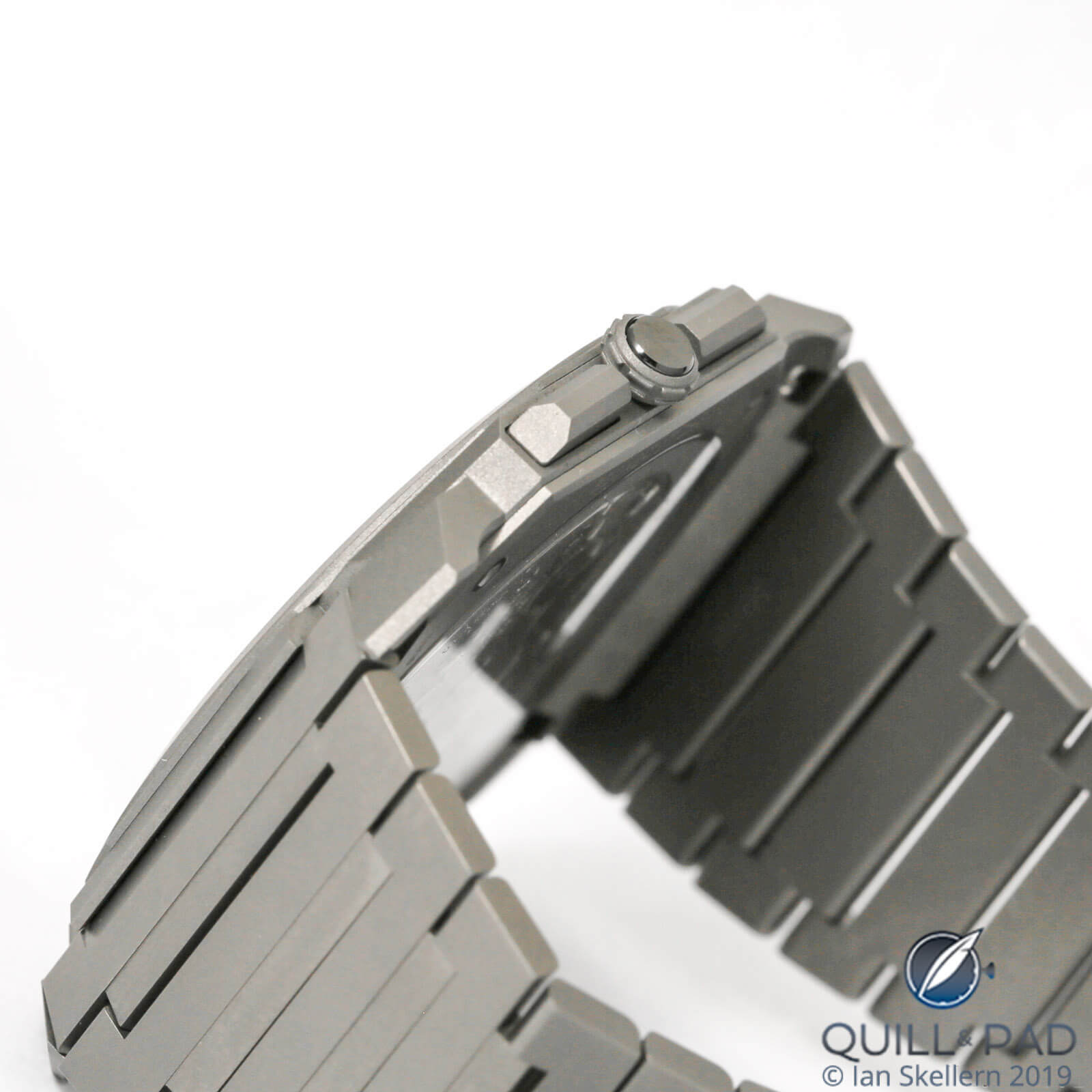
Bulgari Octo Finissimo Chronograph GMT
Don’t forget, though, that both the chronograph pushers and the GMT pusher actuate their respective mechanisms from the side of the movement, so just the act of moving the rotor to the periphery isn’t without issues.
It has to be thin enough itself to allow access to the side of the movement to actuate levers without touching the spinning rotor. Every choice requires considering numerous other aspects when thinness is the goal.
One might have guessed that Bulgari would have the GMT hour adjuster operate through the crown, but still the engineers chose to have a separate pusher for quick-change ability.
I’m guessing that when considering the engineering decisions needed for clearance of the chronograph pushers, the choice was intuitive because components wouldn’t have to be added to the winding mechanism but could be pushed to the edge of the movement, once again saving thickness.
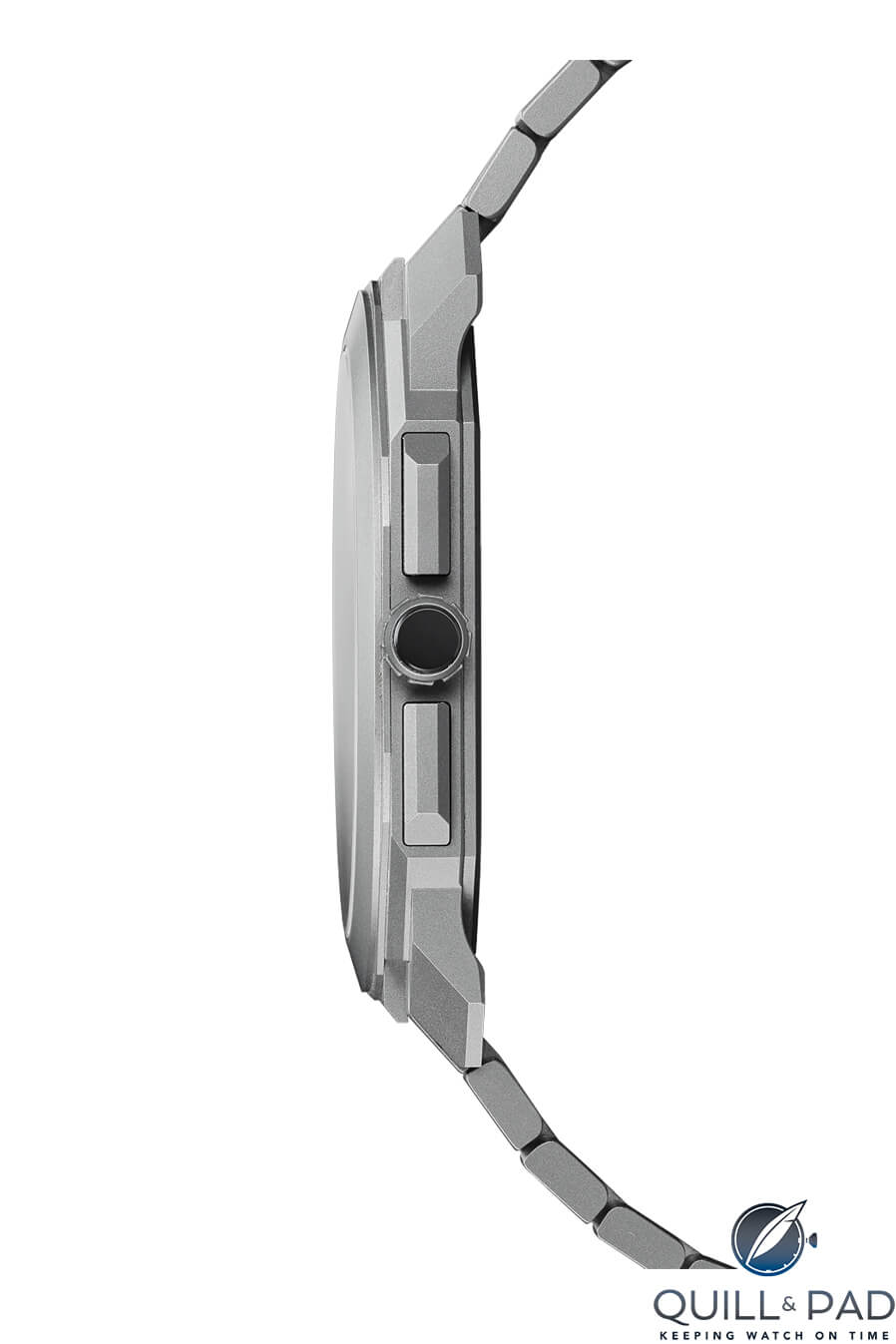
Breathe in! Bulgari Octo Finissimo Chronograph GMT from the side
And all of the work to keep the movement thin was worth the effort: it comes in at a very skinny 3.3 millimeters, beating the previous chronograph record of 3.95 millimeters set 32 years ago by Frédéric Piguet Caliber 1180 (which was not automatic and didn’t have an added GMT function).
In this new iteration of the Octo Finissimo, the case design actually wasn’t a hindrance since it has a little more room to work with compared to the original Octo Finissimo Tourbillon, whose case was nearly two millimeters thinner.
The watch is a stunning creation, and on the heels of so many world records it’s no surprise that it was honored at the 2019 GPHG as the best chronograph of the year.
I’m sure for many it checks a lot of boxes. I personally would love to have this in my collection.
Unlike the tourbillon and minute repeater versions, this chronograph is somewhat accessible, coming in at a bit over $17,000. I have a feeling this piece will be a standout for the brand – a brand that has already had quite a few standouts in the past.
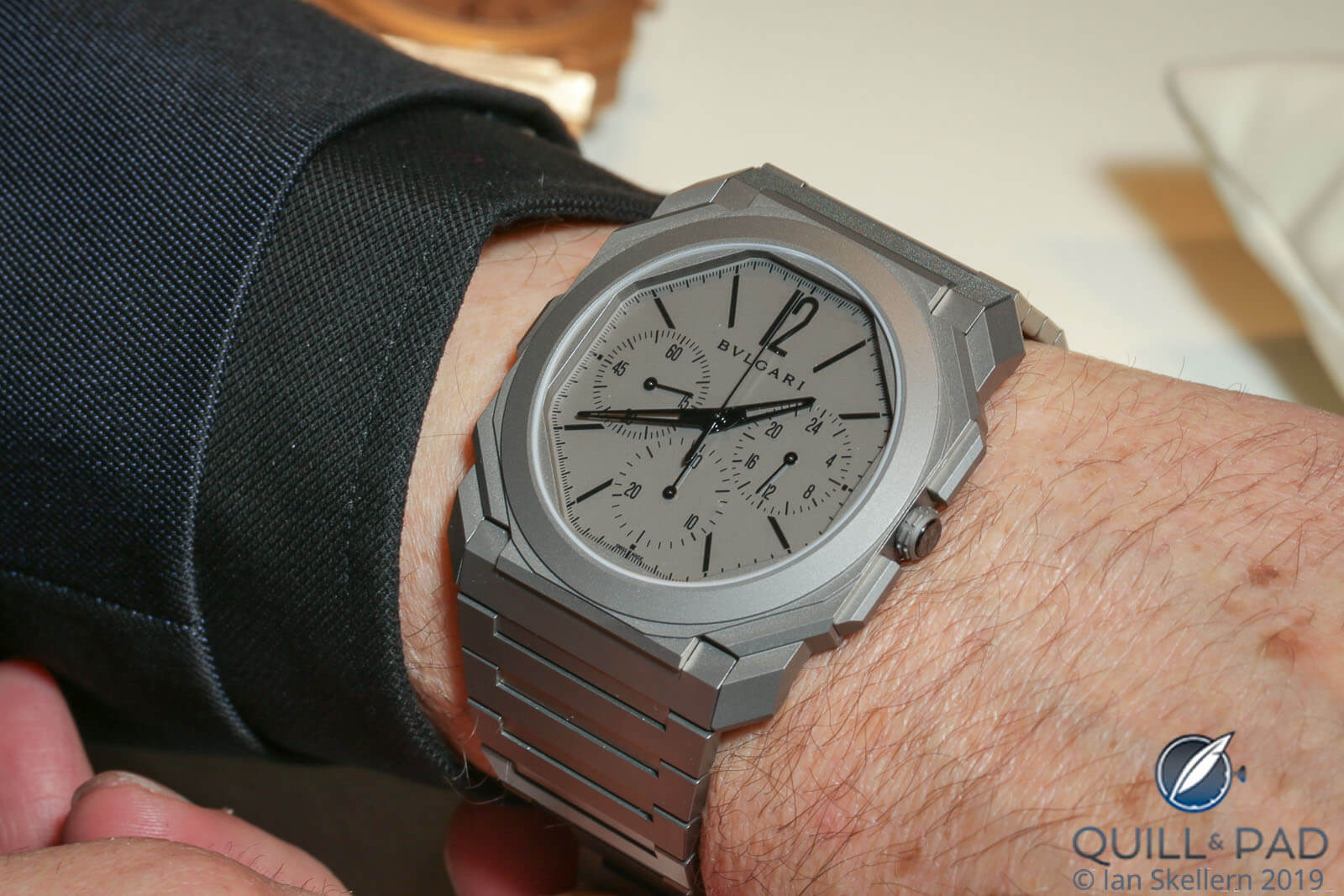
Bulgari Octo Finissimo Chronograph GMT
The Octo Finissimo Chronograph GMT isn’t limited either, so all this awesomeness will be available for a while.
After six years of innovation in the arena of ultra-thin watches, I can’t wait to see the next horological mechanism to go under Bulgari’s proverbial knife!
While we wait, let’s break the chronograph down!
- Wowza Factor * 9.3 The fact that it is an automatic chronograph and is thinner than most “thin” time-only watches is outstanding!
- Late Night Lust Appeal * 95» 931.631m/s2 The amount of lust is inversely proportional to its thickness!
- M.G.R. * 68.5 The engineering prowess and quality found in the BVL 318 cannot be underestimated!
- Added-Functionitis * Moderate Even though the application is in a form that is hard to believe, the watch still only bears a chronograph (with chronograph seconds and 30-minute counter) and a GMT function. Very useful, but the swelling is still manageable and only requires regular strength Gotta-HAVE-That cream!
- Ouch Outline * 10.4 The ear-piercing sound of high-pressure air blasting you in the face! You don’t need to already have hearing damage like myself to understand the excruciating feeling of 150 psi air hissing like a whistle while your ears try desperately to shut off. Still, this is quite the watch and I might just accept needing a hearing aid if it got this watch on my wrist!
- Mermaid Moment * Just put it on! With ultra-thin watches the best way to fall head over heels is simply to put it on the wrist, then you realize that you aren’t complete without it!
- Awesome Total * 934.35 Begin with the hours of power reserve (55) and multiply by the thickness of the case in millimeters (6.9), then multiply by the thickness of the movement in millimeters (3.3) before subtracting the number of the caliber (318) to get a seriously svelte awesome total!
For more information, please visit www.bulgari.com.
Quick Facts Bulgari Octo Finissimo Chronograph GMT Automatic
Case: 42 x 6.9 mm, sandblasted matte grey titanium
Movement: automatic Caliber BVL 318 with peripheral rotor and column-wheel chronograph, 3.3 mm in height, 55-hour power reserve,
Functions: hours, minutes, seconds; chronograph, GMT/24-hour second time zone
Price: $17,600
You may also enjoy:
Bulgari Octo Finissimo Automatic: To Live With Is To Love
Bulgari’s Beloved Serpenti: A Brief History
Bulgari Daniel Roth Carillon Tourbillon: Passion Begins Early
Leave a Reply
Want to join the discussion?Feel free to contribute!





















































Can you please send me more information about these time passes thank you for your kind response Kenneth Fawcett